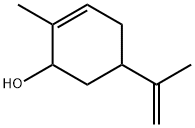Geraniol , StandardforGC,≥99.0%(GC) , 106-24-1
Synonym(s):
trans-3,7-Dimethyl-2,6-octadien-1-ol
CAS NO.:106-24-1
Empirical Formula: C10H18O
Molecular Weight: 154.25
MDL number: MFCD00002917
EINECS: 203-377-1
| Pack Size | Price | Stock | Quantity |
| 5ML | RMB79.20 | In Stock |
|
| others | Enquire |
PRODUCT Properties
| Melting point: | -15 °C |
| Boiling point: | 229-230 °C (lit.) |
| Density | 0.879 g/mL at 20 °C (lit.) |
| vapor density | 5.31 (vs air) |
| vapor pressure | ~0.2 mm Hg ( 20 °C) |
| FEMA | 2507 | GERANIOL |
| refractive index | n |
| Flash point: | 216 °F |
| storage temp. | 2-8°C |
| solubility | water: soluble0.1g/L at 25°C |
| form | Liquid |
| pka | 14.45±0.10(Predicted) |
| Specific Gravity | 0.878~0.885 (20/4℃) |
| color | Clear colorless to pale yellow |
| Odor | at 100.00 %. sweet floral fruity rose waxy citrus |
| Odor Type | floral |
| biological source | synthetic |
| Water Solubility | PRACTICALLY INSOLUBLE |
| Merck | 14,4403 |
| JECFA Number | 1223 |
| BRN | 1722456 |
| Stability: | Stable. Combustible. Incompatible with strong oxidizing agents. |
| InChIKey | GLZPCOQZEFWAFX-JXMROGBWSA-N |
| LogP | 2.6 at 25℃ |
| CAS DataBase Reference | 106-24-1(CAS DataBase Reference) |
| NIST Chemistry Reference | 2,6-Octadien-1-ol, 3,7-dimethyl-, (E)-(106-24-1) |
| EPA Substance Registry System | trans-Geraniol (106-24-1) |
Description and Uses
Geraniol has a characteristic rose-like odor. Geraniol may be prepared by fractional distillation from those essential oils rich in geraniol, or synthetically from myrcene; commercial geraniol cannot be classified according to its alcohol content, as most of the recurring impurities are alcoholic in nature (nerol, citronellol, tetrahydrogeraniol). Gas-chromatography techniques may be usefully employed to determine the geraniol content in a product.
geraniol is perfuming and with tonic properties. It is a primary constituent in many essential oils, including citronella, lavender, lemongrass, orange flower, and ylang-ylang.
Safety
| Symbol(GHS) |   GHS05,GHS07 |
| Signal word | Danger |
| Hazard statements | H315-H317-H318 |
| Precautionary statements | P261-P264-P272-P280-P302+P352-P305+P351+P338 |
| Hazard Codes | Xi |
| Risk Statements | 36/37/38-43-41-36-52/53-38 |
| Safety Statements | 26-36-24/25-36/37-61-36/37/39 |
| RIDADR | UN1230 - class 3 - PG 2 - Methanol, solution |
| WGK Germany | 1 |
| RTECS | RG5830000 |
| Hazard Note | Irritant |
| TSCA | Yes |
| HS Code | 29052900 |
| Hazardous Substances Data | 106-24-1(Hazardous Substances Data) |
| Toxicity | The acute oral LD50 value in rats was reported as 3.6 g/kg (Jenner, Hagan, Taylor, Cook & Fitzhugh, 1964) and as 4.8 g/kg, while the iv UD 50 in rabbits was reported as 50 mg/kg (Yamawkai, 1962). The acute dermal LD50 value in rabbits was reported as > 5 g/kg (Moreno, 1972). |





